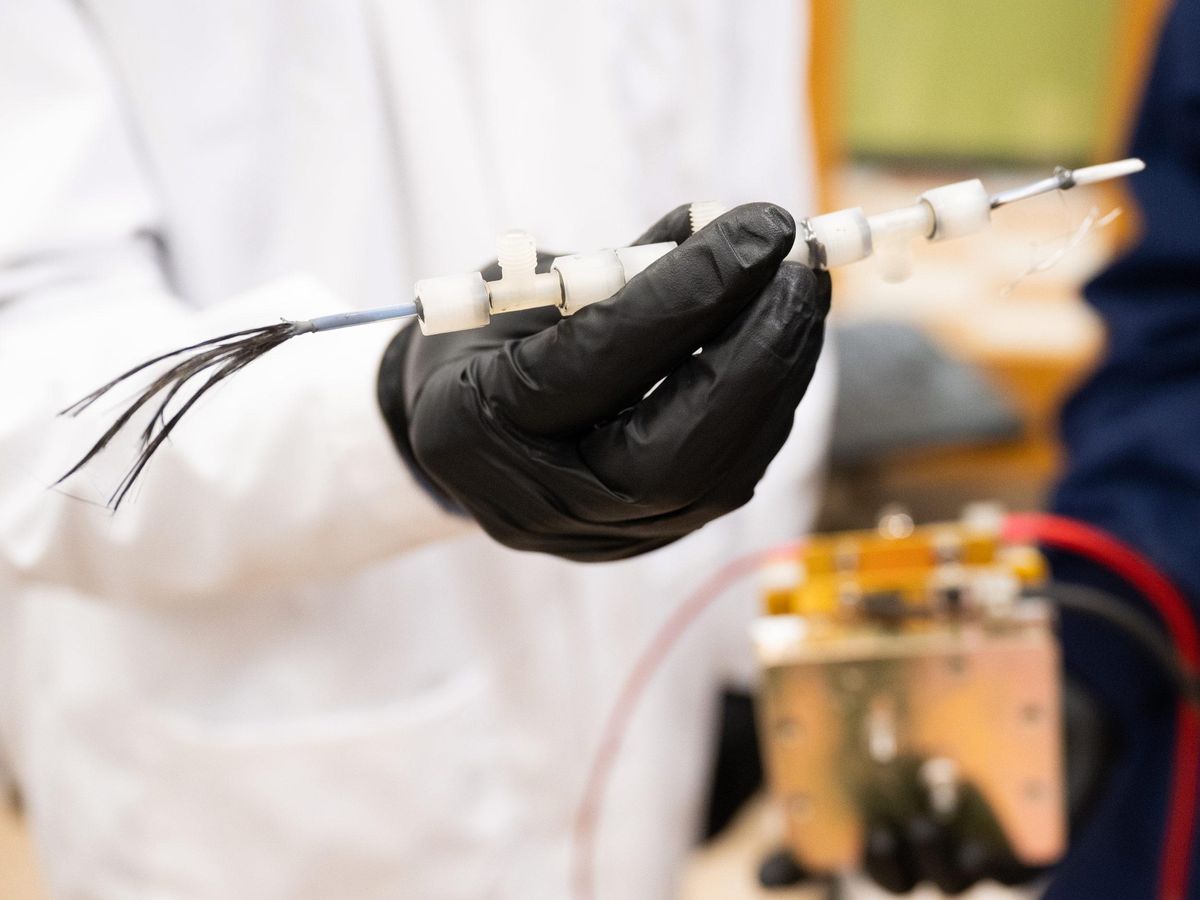By replacing the traditionally flat electrodes and membranes in a flow battery cell with wire electrodes and tubular membranes, researchers have shrunk the battery cell size by 75 percent. This reduction in footprint and complexity could cut the cost of flow batteries, an important front-runner to store renewable energy on the grid.
Solar and wind power are growing faster than ever, according to the International Energy Agency. Making these intermittent energy sources a regular part of the grid without causing instabilities will require batteries to store energy on a large scale.
Flow batteries are a promising technology for that. Unlike lithium-ion batteries, which store energy in solid electrodes, flow batteries store chemical energy in liquid electrolytes that sit in tanks. This stored charge is converted into an electric current (and vice versa) in a power module, which is a stack of electrochemical cells.
Each cell has a positive and negative electrode, separated by a membrane that allows certain ions to move through when the battery is charging and discharging. To operate the battery, two electrolytes are pumped through either side of the reactor cell.
Flow batteries can, in theory, be easily scaled up to megawatt-hours by increasing the size of the tanks. They can also have longer lifetimes and be safer than lithium ion. They remain costly, though, with a capital cost of around US $800 per kilowatt-hour, more than twice that of lithium-ion batteries. “But they can be much cheaper, and our work accelerates this process,” says Nian Liu, a chemical and biomolecular engineering professor at the Georgia Institute of Technology.
Liu and colleagues focused on redesigning the power module, which makes up 40 percent of the cost of a flow battery. Today’s cells are still based on a decades-old configuration of flat end plates, electrodes, and membranes. They also have several inactive parts, such as frames, rubber gaskets, bipolar plates, and flow distributors, which occupy most of the cell volume, bringing down the cell’s power density. “They also make it expensive,” Liu says. “And they are not necessary.”
The team’s new cell configuration, borrowed from the chemical-separation industry, eliminates these components. In their design, a 0.65-millimeter-wide tube, made of the ion-transporting material Nafion, acts as the membrane. The researchers thread a carbon-fiber cathode through the tube. Then they place four of these tubes inside a bigger, 2 mm plastic tube, and push a zinc wire through to serve as the anode. During operation, the team pumps one electrolyte through the outer plastic tube, and the other electrolyte through the four smaller tubes inside.
The distance between the electrodes and membranes goes down from the few millimeters common in a planar cell to less than a millimeter in this design, boosting power density. “We make the thing very compact,” Liu says. “So we use less material to achieve the same performance. Less material means it is cheaper.”
A proof-of-concept test using zinc-iodine chemistry—one of the common ones used in flow-battery technology—showed that the battery had a charge densities of about 1,322 watts per liter of electrolyte and a discharge density of about 306 W/L. For a conventional planar cell, those numbers are under 60 W/L and 45 W/L, respectively. The battery lasted through over 2,500 charge cycles and is compatible with other typical flow-battery chemistries, the researchers reported on 3 January in the journal Proceedings of the National Academy of Sciences.
Liu estimates that the tubular design should cut the cost of flow-battery power modules by roughly half. Plus, all the components in the cell are off the shelf, and scaling up the reactor cell design should be easy, since it is based on a commonly used design in the chemical industry.
He expects that the overall cost of flow batteries should go down in coming years. There is a lot of ongoing research on improving electrolytes already, he says, “and also people are starting to think about recycling electrolytes. If this is demonstrated, then the electrolyte cost can be significantly reduced.”
The team will soon sign a research contract with a flow-battery company, which will sponsor further research on scaling up and benchmarking the tubular flow cell, and analyzing the design at a larger system level.
This article appears in the May 2023 print issue as “Building a Better Flow Battery for Grid Storage.”
- Iron-Chromium Flow Battery Aims to Replace Gas Plants ›
- New Sulfur Flow Battery for Affordable Long-Term Grid Storage ›
Prachi Patel is a freelance journalist based in Pittsburgh. She writes about energy, biotechnology, materials science, nanotechnology, and computing.



